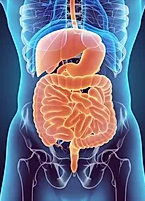Gastrointestinal Cancer Types and
Radio Therapy Treatment Options
Gastrointestinal cancer is a term that encompasses a large group of cancers that affect the gastrointestinal tract. At ICI we specialize in treating those cancers quickly and effectively with the help of cutting edge technology
Types of Gastrointestinal Cancer
Various types of gastrointestinal cancer include:
- Esophageal cancer
- Stomach cancer
- Gallbladder cancer
- Liver cancer
- Pancreatic cancer
- Colon cancer
- Rectal cancer
- Anal cancer

Colorectal Cancer
Cancer of the large bowel is second only to lung cancer as a cause of cancer death in the United States: 136,000 new cases occurred in 2016 and more than 50,000 deaths were caused to colorectal cancer. Risk factors include: diet, smoking, alcohol, lack of physical activity, family history of colon cancer and colon polyps, presence of colon polyps, race, and even diseases such as diabetes and obesity.
Most colorectal cancers arise from adenomatous polyps. A polyp is a grossly visible protrusion from the mucosa of the colon into the lumen of the gut. They can be classified as hyperplastic polyps which are benign, or adenomatous polyps which have the potential to become cancers. Most polyps produce no symptoms and remain clinically undetected.
Colorectal Cancer Screening
- Digital rectal exam
- Fecal occult blood exams
- Radiographic studies such as barium enemas or CT colonography
- Colonoscopy
Occult blood in the stool is found in 5% of the patients with these polyps. The probability of an adenomatous polyp to become cancerous depends on the gross appearance of the lesion, its histology and its size. The likelihood that any polyp contains cancer is relative to the size of the polyp, being negligible (<2%) in lesions smaller than 1.5 cm, intermediate (2-10%) in lesions from 1.5-2.5 cm and substantial (>10%) in lesions larger than 2.5 cm in size.
Although colonic polyps can be detected by using X-rays such as Barium Enemas or CT-colonography, most polyps in the United States are detected using colonoscopy. The advantages of colonoscopy over X-rays are that at the time of detection the polyp can be resected. At that time, the histologic nature of the polyp can be ascertained and most of the times no further therapy is needed. However, following detection of an adenomatous polyp the entire large bowel should be visualized endoscopically because other synchronous lesions are noted in 1/3 of patients.
Colonoscopy should then be repeated periodically because such patients are at a higher than average risk of developing colorectal cancer. Adenomatous polyps are thought to require more than 5 years of growth before becoming clinically significant; for that reason colonoscopy does not have to be repeated more frequently than every 3 years for the great majority of patients.
Colonoscopy should then be repeated periodically because such patients are at a higher than average risk of developing colorectal cancer. Adenomatous polyps are thought to require more than 5 years of growth before becoming clinically significant; for that reason colonoscopy does not have to be repeated more frequently than every 3 years for the great majority of patients.
Colon cancer screening is beneficial at detecting precancerous changes and small early tumors in the large intestine and rectum. For adults who are at average risk of colon and rectal cancer, it is recommended to begin screening at age 50. Adults who are classified at higher risk may begin screening earlier at the recommendation of their doctor. Remember that even if you are not experiencing symptoms of colon or rectal cancer, you should always follow your doctor’s screening recommendations, including:
Eating a well-balanced diet is advantageous for many reasons. A diet rich in fruits and vegetables and low in animal fats reduces your risk of some types of gastrointestinal cancer. In addition, eating a well-balanced diet reduces obesity, which has been recognized as a significant risk factor for many types of cancer.
Colorectal Cancer Treatment
Treatment for gastrointestinal cancer depends on the type of cancer, stage, and other general health factors. Common methods of treating gastrointestinal cancer include surgery, chemotherapy and radiation. Sometimes a combination of all methods are used, this is commonly called multidisciplinary management.
Role of Radiation Therapy in Colorectal Cancer
Radiation therapy to the pelvis is recommended for patients with rectal cancer because it reduces the 20-25% probability of regional recurrences following complete surgical resection of stage II or II tumors, especially if they have penetrated through the serosa. This alarmingly high rate of local disease recurrence is believed to be due to the fact that the contained anatomic space within the pelvis limits the extent of the resection and because the rich lymphatic network of the pelvic side wall immediately adjacent to the rectum facilitates the early spread of malignant cells into surgically inaccessible tissue.
Pancreatic Cancer
Pancreatic cancer is the 4th leading cancer death in the United States. Pancreatic cancer arises when cells in the pancreas, a glandular organ behind the stomach, begin to multiply out of control and form a mass. There are a number of types of pancreatic cancer. The most common, pancreatic adenocarcinoma, accounts for about 85% of cases, and the term “pancreatic cancer” is sometimes used to refer only to that type.
Several other types of cancer, which collectively represent the majority of the non-adenocarcinomas, can also arise from these cells. Most of these are neuroendocrine tumors, which arise from the hormone-producing cells of the pancreas. These are generally less aggressive than pancreatic adenocarcinoma.
Multidisciplinary approach
Pancreatic cancer is treated depending on the type and stage of the cancer. Radiation therapy may be used alone, with surgery, with chemotherapy, or with both combined. In other words, the treatment of pancreatic cancer requires a multidisciplinary approach. Dr. Amendola and the oncology staff at ICI will coordinate with other members of your cancer care team to ensure proper treatment and management of your disease.
Radiation Therapy
Radiation therapy is given by ICI to pancreatic cancer patients with high energy X-rays with linear accelerators (LINACs) to destroy cancer cells. Treatment is usually given in daily sessions, 5 times a week for 5 weeks. Modern techniques, such as IMRT and Radiosurgery with Varian Edge™, have shown to be excellent tools in the management of pancreatic cancer. RapidArc™ technology delivers more precise beam shaping than conventional therapy, in a fraction of the time. With these shorter treatment times, higher doses of radiation can be given with significantly fewer side effects. Radiation therapy is commonly used in combination with chemotherapy and surgery.
Surgery
There are 2 general types of surgery used for cancer of the pancreas.
- Potentially curative surgery: The type of surgery most often done if it looks like the cancer can be cured is radical pancreatic resection.
- Palliative surgery: If the tumor is too extensive to be completely removed, surgery is frequently done to relieve symptoms or to prevent certain problems, such as blockage of the bile ducts or the intestine by the cancer in a palliative fashion.
Radiosurgery
Radiosurgery is an excellent tool in the management of pancreatic cancer either in early or advanced tumors. This non-invasive non-surgical procedure done in an outpatient basis and lasts a few minutes.
Chemotherapy
Chemotherapy uses drugs to kill cancer cells, including those that may have spread outside the primary tumor site. Drugs travel throughout the body, making this treatment useful for cancer that has spread beyond the place where it started.
